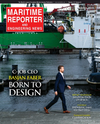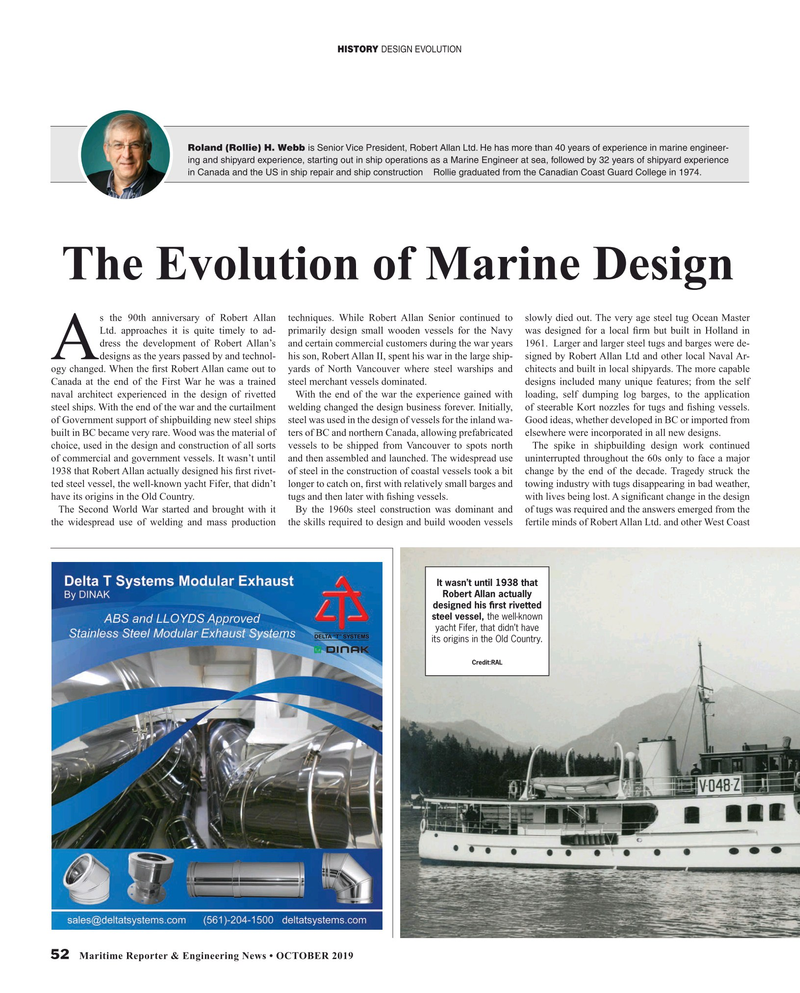
Page 52: of Maritime Reporter Magazine (October 2019)
Marine Design Annual
Read this page in Pdf, Flash or Html5 edition of October 2019 Maritime Reporter Magazine
HISTORY DESIGN EVOLUTION
Roland (Rollie) H. Webb is Senior Vice President, Robert Allan Ltd. He has more than 40 years of experience in marine engineer- ing and shipyard experience, starting out in ship operations as a Marine Engineer at sea, followed by 32 years of shipyard experience in Canada and the US in ship repair and ship construction Rollie graduated from the Canadian Coast Guard College in 1974.
The Evolution of Marine Design s the 90th anniversary of Robert Allan techniques. While Robert Allan Senior continued to slowly died out. The very age steel tug Ocean Master
Ltd. approaches it is quite timely to ad- primarily design small wooden vessels for the Navy was designed for a local ? rm but built in Holland in dress the development of Robert Allan’s and certain commercial customers during the war years 1961. Larger and larger steel tugs and barges were de- designs as the years passed by and technol- his son, Robert Allan II, spent his war in the large ship- signed by Robert Allan Ltd and other local Naval Ar-
A ogy changed. When the ? rst Robert Allan came out to yards of North Vancouver where steel warships and chitects and built in local shipyards. The more capable
Canada at the end of the First War he was a trained steel merchant vessels dominated. designs included many unique features; from the self naval architect experienced in the design of rivetted With the end of the war the experience gained with loading, self dumping log barges, to the application steel ships. With the end of the war and the curtailment welding changed the design business forever. Initially, of steerable Kort nozzles for tugs and ? shing vessels. of Government support of shipbuilding new steel ships steel was used in the design of vessels for the inland wa- Good ideas, whether developed in BC or imported from built in BC became very rare. Wood was the material of ters of BC and northern Canada, allowing prefabricated elsewhere were incorporated in all new designs.
choice, used in the design and construction of all sorts vessels to be shipped from Vancouver to spots north The spike in shipbuilding design work continued of commercial and government vessels. It wasn’t until and then assembled and launched. The widespread use uninterrupted throughout the 60s only to face a major 1938 that Robert Allan actually designed his ? rst rivet- of steel in the construction of coastal vessels took a bit change by the end of the decade. Tragedy struck the ted steel vessel, the well-known yacht Fifer, that didn’t longer to catch on, ? rst with relatively small barges and towing industry with tugs disappearing in bad weather, have its origins in the Old Country. tugs and then later with ? shing vessels. with lives being lost. A signi? cant change in the design
The Second World War started and brought with it By the 1960s steel construction was dominant and of tugs was required and the answers emerged from the the widespread use of welding and mass production the skills required to design and build wooden vessels fertile minds of Robert Allan Ltd. and other West Coast
It wasn’t until 1938 that
Robert Allan actually designed his ? rst rivetted steel vessel, the well-known yacht Fifer, that didn’t have its origins in the Old Country.
Credit:RAL 52 Maritime Reporter & Engineering News • OCTOBER 2019
MR #10 (50-57).indd 52 10/4/2019 11:54:00 AM

 51
51

 53
53
